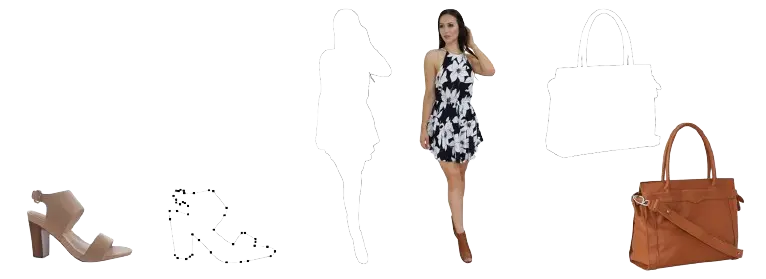As technology continues to evolve, the field of image editing is no exception. Multiple Clipping Path technology, which allows for the isolation and manipulation of various elements within an image, is advancing rapidly. In this article, we will delve into the future trends shaping the landscape of multiple clipping path technology.
Future Trends in Multiple Clipping Path Technology
Artificial Intelligence (AI) Integration:
One of the most prominent trends in multiple clipping path technology is the integration of artificial intelligence. AI algorithms are increasingly being employed to automate and enhance the precision of path creation. Machine learning models can analyze image content, identify objects, and generate multiple paths with minimal human intervention, significantly speeding up the editing process.
Automated Path Generation:
The future of multiple clipping path technology will witness a shift towards more automated path generation. Advanced algorithms will be capable of recognizing and outlining objects within an image without manual input. This automation not only accelerates the editing workflow but also reduces the margin for human error.
Real-time Collaboration Platforms:
Emerging trends suggest the development of real-time collaboration platforms for multiple clipping path services. Cloud-based solutions will enable seamless collaboration between designers and clients, fostering efficient communication, and allowing for instant feedback and revisions.
3D Clipping Paths:
The evolution of multiple clipping path technology is likely to extend into the realm of three-dimensional editing. Future tools may provide the capability to create clipping paths for 3D objects within images, offering a new dimension of creative possibilities for designers and businesses involved in product visualization.
Augmented Reality (AR) Integration:
With the rise of augmented reality applications, multiple clipping path technology is expected to integrate with AR. This could enable the precise isolation of objects in images for seamless integration into augmented reality environments, enhancing the immersive and interactive aspects of AR experiences.
Enhanced Edge Detection Algorithms:
Improved edge detection algorithms will play a crucial role in the future of multiple clipping path technology. These algorithms will be more adept at distinguishing complex object boundaries, ensuring greater accuracy in path creation, even for images with intricate details.
Cross-platform Compatibility:
Future multiple clipping path tools are likely to be more versatile, offering cross-platform compatibility. Designers will have the flexibility to work on various devices and operating systems seamlessly, promoting a collaborative and adaptable editing environment.
Dynamic Editing Environments:
The future holds the promise of dynamic editing environments where designers can edit multiple clipping paths interactively. This might include real-time adjustments, visualizations, and instant previews, providing a more intuitive and user-friendly experience.
Ethical AI Practices:
As AI becomes more prevalent in multiple clipping path technology, there will be a growing emphasis on ethical AI practices. This includes addressing bias in algorithms, ensuring transparency in decision-making processes, and prioritizing user privacy and data security.
Integration with Virtual Reality (VR):
Looking further ahead, integration with virtual reality (VR) technologies may become a reality in multiple clipping path services. Designers could immerse themselves in a virtual environment to manipulate and refine clipping paths in a more immersive and intuitive way.
Also Read:

Top 10 Advanced Clipping Path Tools
Several advanced clipping path tools are widely used in the industry. Keep in mind that newer tools may be introduced since the content is published. It’s always a good idea to check for the latest developments. Here are some of the most advanced clipping path tools:
Adobe Photoshop:
Adobe Photoshop remains a go-to tool for professional image editing and clipping path services. With its Pen Tool, designers can create precise paths around objects. The latest versions also feature improved AI-driven selection tools for faster and more accurate clipping.
GIMP (GNU Image Manipulation Program):
GIMP is a free and open-source alternative to Photoshop. It offers a variety of selection tools, including the Paths Tool, which allows users to create and edit paths for clipping. While not as feature-rich as Photoshop, GIMP is a powerful tool for those on a budget.
CorelDRAW:
CorelDRAW is a vector graphics editor that provides advanced tools for creating paths and performing clipping. It’s particularly useful for designers working on illustrations, logos, and vector-based images.
Pixlr:
Pixlr is an online photo editing tool that provides a user-friendly interface and advanced features for creating clipping paths. It’s accessible through a web browser, making it convenient for quick edits without the need for software installation.
Clipping Magic:
Clipping Magic is an online tool specifically designed for removing backgrounds and creating clipping paths. It uses advanced algorithms to automatically detect and separate foreground from background, making it a quick solution for basic clipping needs.
Pen Tool in Affinity Photo:
Affinity Photo is gaining popularity as a powerful alternative to Adobe Photoshop. Its Pen Tool allows for precise path creation, making it suitable for complex clipping tasks. Affinity Photo is available for both Windows and macOS.
Inkscape:
Inkscape is a free and open-source vector graphics editor that includes powerful path editing tools. It’s suitable for creating clipping paths and is particularly useful for working with scalable vector graphics (SVG).
PathAI:
PathAI is an advanced tool that utilizes artificial intelligence for automatic path creation. It’s designed to simplify the clipping path process by intelligently identifying and outlining objects in images.
Snipping Magic:
Snipping Magic is an online tool that uses AI to automatically detect and separate objects from their backgrounds. It’s user-friendly and can be a quick solution for basic clipping needs.
Fluid Mask:
Fluid Mask is a standalone tool designed for advanced image masking and clipping. It provides sophisticated tools for precise selections and is particularly useful for complex images with intricate details.
Before choosing a tool, it’s essential to assess your specific needs, the complexity of the images you’re working with, and your level of expertise. Additionally, stay updated on the latest developments in image editing software, as new tools and features are frequently introduced to the market.
End Words
The future trends in multiple clipping path technology promise a more automated, efficient, and creative editing process. As AI, automation, and new technological frontiers continue to reshape the industry, designers and businesses can anticipate a future where multiple clipping path services are not only more powerful but also more accessible and user-friendly. Staying abreast of these trends will be key to harnessing the full potential of cutting-edge image editing tools.



